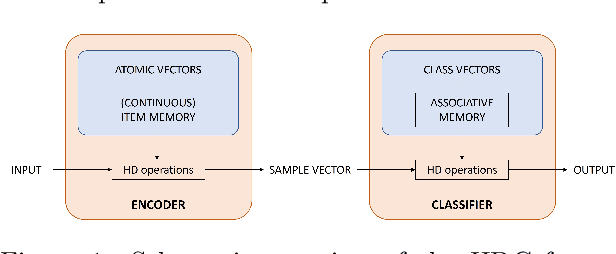Ing Jyh Tsang
Twin Network Augmentation: A Novel Training Strategy for Improved Spiking Neural Networks and Efficient Weight Quantization
Sep 24, 2024



Abstract:The proliferation of Artificial Neural Networks (ANNs) has led to increased energy consumption, raising concerns about their sustainability. Spiking Neural Networks (SNNs), which are inspired by biological neural systems and operate using sparse, event-driven spikes to communicate information between neurons, offer a potential solution due to their lower energy requirements. An alternative technique for reducing a neural network's footprint is quantization, which compresses weight representations to decrease memory usage and energy consumption. In this study, we present Twin Network Augmentation (TNA), a novel training framework aimed at improving the performance of SNNs while also facilitating an enhanced compression through low-precision quantization of weights. TNA involves co-training an SNN with a twin network, optimizing both networks to minimize their cross-entropy losses and the mean squared error between their output logits. We demonstrate that TNA significantly enhances classification performance across various vision datasets and in addition is particularly effective when applied when reducing SNNs to ternary weight precision. Notably, during inference , only the ternary SNN is retained, significantly reducing the network in number of neurons, connectivity and weight size representation. Our results show that TNA outperforms traditional knowledge distillation methods and achieves state-of-the-art performance for the evaluated network architecture on benchmark datasets, including CIFAR-10, CIFAR-100, and CIFAR-10-DVS. This paper underscores the effectiveness of TNA in bridging the performance gap between SNNs and ANNs and suggests further exploration into the application of TNA in different network architectures and datasets.
An Encoding Framework for Binarized Images using HyperDimensional Computing
Dec 01, 2023



Abstract:Hyperdimensional Computing (HDC) is a brain-inspired and light-weight machine learning method. It has received significant attention in the literature as a candidate to be applied in the wearable internet of things, near-sensor artificial intelligence applications and on-device processing. HDC is computationally less complex than traditional deep learning algorithms and typically achieves moderate to good classification performance. A key aspect that determines the performance of HDC is the encoding of the input data to the hyperdimensional (HD) space. This article proposes a novel light-weight approach relying only on native HD arithmetic vector operations to encode binarized images that preserves similarity of patterns at nearby locations by using point of interest selection and local linear mapping. The method reaches an accuracy of 97.35% on the test set for the MNIST data set and 84.12% for the Fashion-MNIST data set. These results outperform other studies using baseline HDC with different encoding approaches and are on par with more complex hybrid HDC models. The proposed encoding approach also demonstrates a higher robustness to noise and blur compared to the baseline encoding.
The Trifecta: Three simple techniques for training deeper Forward-Forward networks
Nov 29, 2023Abstract:Modern machine learning models are able to outperform humans on a variety of non-trivial tasks. However, as the complexity of the models increases, they consume significant amounts of power and still struggle to generalize effectively to unseen data. Local learning, which focuses on updating subsets of a model's parameters at a time, has emerged as a promising technique to address these issues. Recently, a novel local learning algorithm, called Forward-Forward, has received widespread attention due to its innovative approach to learning. Unfortunately, its application has been limited to smaller datasets due to scalability issues. To this end, we propose The Trifecta, a collection of three simple techniques that synergize exceptionally well and drastically improve the Forward-Forward algorithm on deeper networks. Our experiments demonstrate that our models are on par with similarly structured, backpropagation-based models in both training speed and test accuracy on simple datasets. This is achieved by the ability to learn representations that are informative locally, on a layer-by-layer basis, and retain their informativeness when propagated to deeper layers in the architecture. This leads to around 84\% accuracy on CIFAR-10, a notable improvement (25\%) over the original FF algorithm. These results highlight the potential of Forward-Forward as a genuine competitor to backpropagation and as a promising research avenue.
Training a HyperDimensional Computing Classifier using a Threshold on its Confidence
May 30, 2023Abstract:Hyperdimensional computing (HDC) has become popular for light-weight and energy-efficient machine learning, suitable for wearable Internet-of-Things (IoT) devices and near-sensor or on-device processing. HDC is computationally less complex than traditional deep learning algorithms and achieves moderate to good classification performance. This article proposes to extend the training procedure in HDC by taking into account not only wrongly classified samples, but also samples that are correctly classified by the HDC model but with low confidence. As such, a confidence threshold is introduced that can be tuned for each dataset to achieve the best classification accuracy. The proposed training procedure is tested on UCIHAR, CTG, ISOLET and HAND dataset for which the performance consistently improves compared to the baseline across a range of confidence threshold values. The extended training procedure also results in a shift towards higher confidence values of the correctly classified samples making the classifier not only more accurate but also more confident about its predictions.
 Add to Chrome
Add to Chrome Add to Firefox
Add to Firefox Add to Edge
Add to Edge